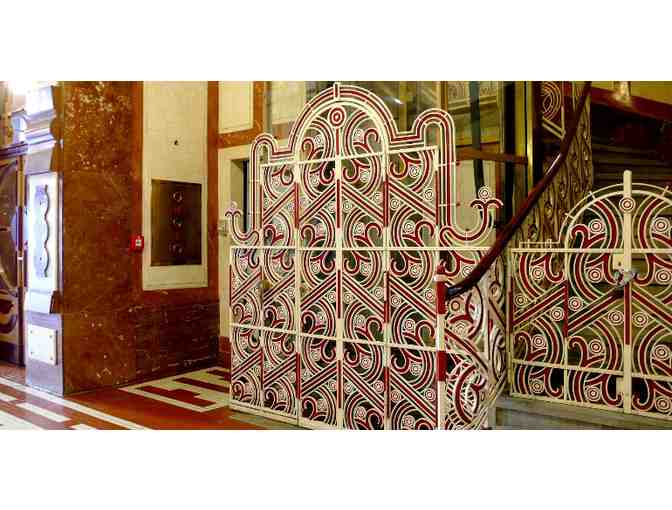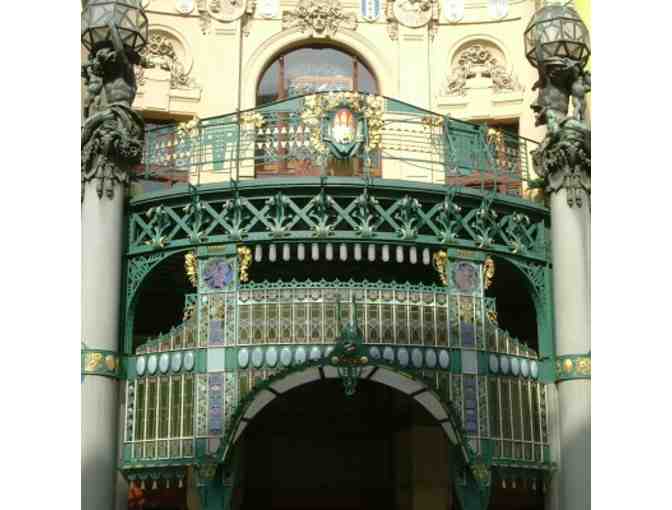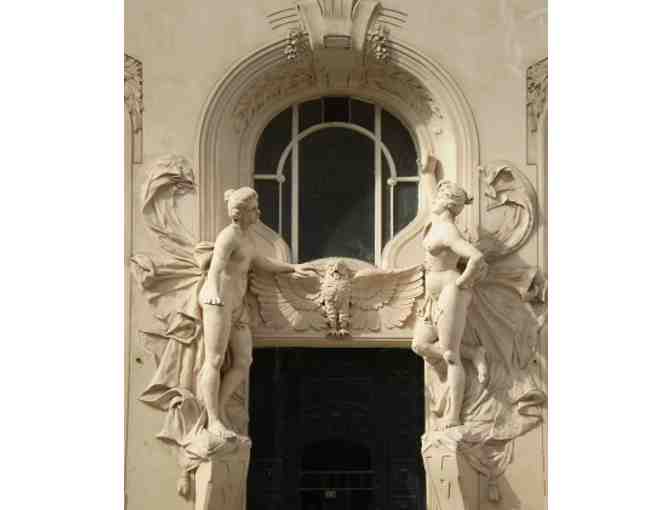Unique Experiences
CZECH REPUBLIC: Explore Prague Art Nouveau/Cubism with a Historian
- Item Number
- CZE508
- Estimated Value
- 295 USD
- Sold
- 200 USD to jb46546ee
- Number of Bids
- 11 - Bid History
Item Description
3-hour guided walk with a historian for a private group of 1-6
In France, it was called Art Nouveau and Style Moderne, and once this modern manner dominated the 1900 World Exhibition in Paris, it came to be known as Style 1900; it was also referred to as Style Metro (after Paris metro designer Hector Guimard) as well as Style Mucha (after the great Czech graphic artist whose posters are considered Art Nouveau par excellence). In Munich and Berlin it was called Jugendstil, and in Austria-Hungary it was known as the Sezession. The Belgians proudly called it Mouvement or Ligne Belge (Belgian Line). Art Nouveau was a truly universal turn-of-the-century phenomenon and it was eagerly, even ecstatically adopted in Prague. In fact, Art Nouveau architecture influenced the city-scape of Prague as significantly as did the Gothic and the Baroque before it. At the end of the 19th and the beginning of the 20th centuries Prague was experiencing a whirlwind of national revival activity and ultimately this movement was embodied in the form of Art Nouveau. From the Main Train Station to the monumental Municipal House, to the entire district of Josefov (the former Jewish Ghetto), Art Nouveau constructions represent some of the most significant sights of this city.
Most of us--when we think of the Art Nouveau buildings and fine art of the early 20th century--automatically picture intricate floral forms in ironwork and those dreamy, mythic Art Nouveau women with flowing hair. On Insight walks in Prague, we emphasize that these commonly recognized features of Art Nouveau aesthetics cannot be fully understood without taking into account the new culture of cosmopolitan entertainment, enthusiastic consumption, new opportunities for travel and leisure, and an array of modern technological conveniences that arose at the turn-of-century. While every major Czech artist of the period contributed to the flamboyant Art Nouveau designs of Prague's Municipal House; equally important, the building was also one of the first in the city to be equipped with central heating and ventilation, a drinking and utility water-supply system, electrical as well as hydraulic elevators, a steam-powered laundry and an intercom network.
Put simply, Art Nouveau isn't only a radical new design aesthetic. It represents a pre-war social elite with new standards for modern comforts and luxury, a clubby upper-class who drank absinthe and the first mixed-cocktails, booked voyages on ocean liners, sent telegrams, and read fashion magazines. It isn’t an accident that most Art Nouveau buildings are hotels, elegant bars and restaurants, and train stations. These were the watering holes of the first globe-trotters, those enjoying the fruits of nineteenth-century industrialization in the short-lived first decade of the 20th century just before global war swallowed up their world.
During this walk, you’ll learn to recognize the features of Art Nouveau, from the gingko bilabo leaves on facades which reveal the style's oriental influences to the elaborate light fixtures that mark Art Nouveau interiors to the curvy, campy typography on building signs that echo contemporary magazine and poster graphics. You’ll visit the beautiful Lucerna bar (once owned by Vaclav Havel's family) and the elegant Grand Hotel Europa, examples of a moment of Czech optimism at the turn-of-century, signaling the region's transcendence of older ethnic grievances and its readiness to join Europe by participating in European-wide avant-gardes. As an important parallel, throughout the walk, we visit examples of Prague's Cubist and Rondocubist architecture, including The House of the Black Madonna (created by Josef Gocar in 1910 as an urbane department store) and the Legion's Bank. In many respects, Prague's Cubist architecture (a building style unknown outside of the Czech Republic) surpassed even Art Nouveau as a statement of the city'snewfound sense of modern sophistication and resurgent national identity.
Item Special Note
The guides at Insight Cities are professors, doctoral students, historians, journalists, art critics and published authors. As professional researchers and educators, we cater to visitors who want to enjoy spirited and informed presentations of the cultural and political histories of great cities.
Prague Art Nouveau tour we are offering was featured as one of five best architecture tours in Europe in the UK journal The Week and as one of ten best in the world in The Guardian.
Valid for 3 years following close of Auction.
* * * * * * * * * * * * * * * * * * * * * * * * * * * * * * * * * * * * * *
“Both donor(s) and buyer(s) certify that they are US citizen(s)and that these items are donated or purchased respectively, directly from personal funds, not those of a corporation. Buyers proceeds will be remitted directly to the Democratic Party Committee Abroad, (part of the DNC), Wash. DC. All purchases are considered political donations to DPCA and are not tax-deductible."
DPCA is required under US law, by the Federal Elections Commission (FEC) to collect buyer's and donor's voting state, occupation and employer information.
After auction close on Dec 3, winner must supply the following information in order to receive the necessary donor contact information. At that time, please copy the items below and email them with your answers to auction@democratsabroad.org :
- LOT Number: CZE508
- Your residence address:
- US state or US territory you vote in:
- Your Occupation:
- Your Employer:
Donated By:
Democrats Abroad stores data...
Your support matters, so Democrats Abroad would like to use your information to keep in touch about things that may matter to you. If you choose to hear from Democrats Abroad, we may contact you in the future about our ongoing efforts.
Your privacy is important to us, so Democrats Abroad will keep your personal data secure and Democrats Abroad will not use it for marketing communications which you have not agreed to receive. At any time, you may withdraw consent by emailing Privacy@frontstream.com or by contacting our Privacy Officer. Please see our Privacy Policy found here PrivacyPolicy.



